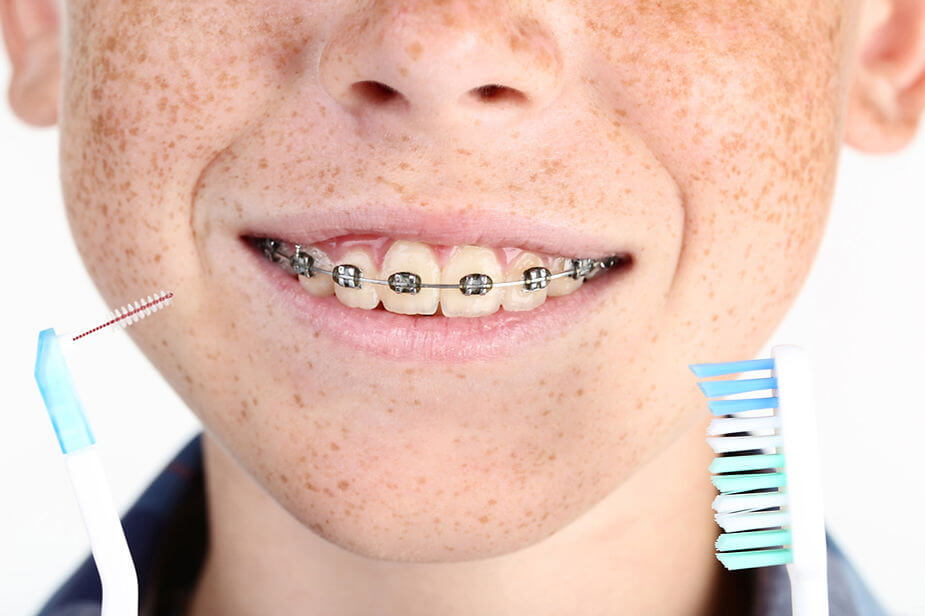For the most part, we take for granted the fact that braces do work.
However, the science behind how braces move your teeth is both interesting and helpful to know if you are considering them.
Going into your appointment with an understanding of how the process works will help you comprehend what your orthodontist is talking about, and help you ask informed questions.

While there are many types of braces, traditional braces are probably the ones you picture. There are four main components of traditional braces: brackets, bonding material, archwire, and ligature elastics. Brackets can be metal or ceramic and are attached to each individual tooth. Bonding material is medical grade glue that attaches the bracket to the tooth. Archwire is a thin, metal wire that can be circular or rectangular. This wire connects the brackets and puts pressure on the tooth. Ligature elastics may also be called o-rings. These are small, often colored, ties that connect the archwire and the brackets. Your orthodontist usually changes the o-rings at each orthodontic visit.
These four parts all work together, sometimes with the help of small elastics or rubber bands, to move your teeth. However, the main element in effective orthodontic treatment is pressure or force. The thin, metal archwire that connects to the bracket is the primary “mover” of your teeth. The force exerted by the archwire is constant. Over time, it slowly moves your teeth to where the orthodontist directs them. The amount of force is not monumental, but the small amount of force created and sustained by the brackets and archwire is enough to make a large impact on the position of your teeth.
How is this pressure created? Think of the archwire like a branch of a tree. When you bend the branch of a tree toward the ground by pressing down on it with your hand, it puts upward pressure on your hand because it wants to go back to its original position. Just like that branch, the archwire wants to maintain its original shape. As your orthodontist flexes the archwire into the brackets and ties them there, the archwire constantly tries to move back to its original shape. The brackets attached to it are glued to your teeth, which means the archwire is pushing or pulling your teeth as it tries to move back to its original shape.
Occasionally, spacers or springs are also used between your teeth to apply extra pressure in order to increase space where teeth are crowded.
Your orthodontist, in your personalized care plan, maps out the movement of your teeth before your braces are put on. Then they strategically place both the brackets and the archwire to move your teeth in the direction they need to go. At each visit, as your teeth shift and change, your orthodontist makes careful and specific bends in the wire to make sure pressure is being exerted on your teeth exactly where it is needed so that your teeth move into the correct positions.
This whole process works because your teeth are surrounded by your gums and bones. The roots of your teeth extend into your gums. Each root is held in place by a membrane that is surrounded by bone. As the archwire puts pressure on your teeth, the membrane is affected. On one side, the membrane stretches, and bone is removed. On the other side, the membrane is compressed, and bone can form. This movement guides the tooth in the proper direction and needs to happen slowly so that the bone can change and grow to provide support for the tooth’s new position.
Self-ligating braces are similar to traditional braces, but instead of using ligature elastics a special type of bracket helps the archwire guide your teeth into the correct position. Although they work in nearly the same way as conventional braces do to move your teeth, they allow teeth to move more freely. This often helps them to be more comfortable than their traditional counterpart. Initially, they could cause more irritation to your lips and cheeks, but self-ligating braces are great because they are usually easier to adjust and keep clean.
Invisible aligners work with the same principle as traditional braces. Your orthodontist makes a care plan for your teeth that includes several sets of clear, plastic trays that fit onto your teeth. These trays do not fit your teeth as they currently are. Instead, the trays are made so that pressure is exerted onto your teeth to move them ever so slightly in the direction they need to move. Instead of getting archwire and brackets adjusted at the orthodontist to continue to move and change your teeth, you simply start wearing the next set of invisible braces in your care plan sequence. Each new set of trays puts enough force on your teeth so that they continue to move them to where they need to be, allowing new bone to form and hold your teeth in their new positions.
The process is slow, with teeth moving at about one millimeter per month. Depending on your individual needs, the whole process will be completed sometime between 6 months and 3 years. The average patient has braces for 2 years. Treatment plans are often shorter for children or adolescents than adults because their bones are still growing and solidifying. This allows for the bones to be more responsive to movement. However, treatment for adults is just as effective and the process is the same.
Once braces are off, it is important to be vigilant about wearing your retainer! The retainer is another way of maintaining pressure on your teeth. Keeping pressure on your newly straightened teeth is important because the bones that support your teeth are still growing and stabilizing your teeth in their new positions. Without the retainer, it is easy for your teeth to shift back into their old positions. Depending on your mouth, your teeth may be more prone to moving back into their old positions, even years after getting your braces off. Due to this, orthodontists usually recommend that you wear your retainer nightly on an ongoing basis. This helps make sure your smile remains healthy for a lifetime.
While braces are an important part of dental health, it makes sense that most people want to shorten the amount of time they need to keep their braces on. If you are hoping to get your braces off as soon as possible, there are important things you can do to make sure the process does not take longer than necessary.
First, remember that keeping your mouth clean helps allow your teeth to move into their new positions more quickly. This means it is important to maintain great brushing, flossing, and cleaning habits. While you have braces, it is essential to clean your teeth after every meal because food is more likely to lodge itself between your braces and teeth. It also means staying away from sticky, sugary foods, carbonated drinks, or foods that are hard. These foods, such as popcorn, gum, ice cubes, caramels, chips, and soda, can cause tooth decay or damage to your braces. This can lead to poor dental health and increase the time you have to wear braces.

Second, beware of what you are chewing on. It is important to make sure that when you are eating hard foods, like tough-crusted bread or raw fruits or vegetables, they are cut up into bite-sized pieces. This will help minimize the pressure you are putting on your teeth when you are eating. Similarly, chewing on objects other than food, like pens, straws, or fingernails, can damage your braces. Chewing on your fingernails or fidgeting with your elastic rubber bands can also push your teeth out of line. Ignoring these recommendations can lengthen the amount of time you have to wear braces.
At Jungle Roots, your orthodontic and dental teams will be with you every step of the way to make sure that your journey toward a healthy, beautiful smile will be as comfortable and effective as possible. With bi-yearly cleanings and helpful tips on maintaining great dental hygiene while you have braces, we will also keep you on track to getting your braces off as soon as possible. With good communication and care, we will help you attain the beautifully aligned smile you are working so hard to create.

At Jungle Roots Children’s Dentistry & Orthodontics, we strive to provide the highest comprehensive pediatric and orthodontic dental care in a unique, fun-filled environment staffed by a team of caring, energetic professionals. We believe the establishment of a “dental home” at an early age is the key to a lifetime of positive visits to the dentist.
#Arizona#BabyTeeth#brush#ChildrensDentistAhwatukee#dentalcare#dentist#dentistphoenix#floss#HappyTeeth#HealthyLiving#HealthyTeeth#JungleRoots#JungleRootsAhwatukee#OralHealth#orthodontics#orthodonticspecialist#orthodonticsphoenix#orthojungleroots.com#PediatricDentist#PediatricDentistry#phoenix#Toothbrush
